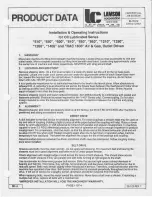
6
Manual 2008 Rev A p/n 2008
Refer to specific data sheets for flow capacities
and vacuum capacities.
OTE:
N
Refer to diagrams in this manual for
proper rotation and orientation in inlet
and discharge.
Tuthill Springfield model 9000 Series rotary lobe
blowers are positive displacement type blowers,
whose pumping capacity is determined by
size, operating speed, and differential pressure
conditions. Blowers employ rotors rotating in
opposite directions within a housing closed at the
ends by end plates.
The inlet to the discharge is sealed with operating
clearances that are very small. Internal lubrication
is not needed, as there is no moving contact.
Clearances between the rotors during rotation are
maintained by a pair of accurately machined helical
timing gears, mounted on the two shafts extended
outside the air chamber. The intermeshing rotary
lobes are designed to rotate and trap air or gas
between each rotor and the housing. As the rotor
lobes rotate past the edge of the suction port, the
trapped air or gas is essentially at suction pressure
and temperature. Since the blower is a constant
volume device, the trapped air remains at suction
pressure until the leading rotor lobe opens into the
discharge port. The close clearances between the
rotors inhibit back slippage of the trapped volume
from between the rotors, and the trapped volume
is forced into the discharge piping. Compression
occurs not internal to the blower but by the amount
of restriction, either downstream of the blower
discharge port or upstream of the blower inlet port.
Figure 4-1
illustrates the air movement within the
machine. In addition, the machine can operate in
either direction.
See Flow by Direction on page
7
.
Never attempt to control capacity by means of a
throttle valve in the intake or discharge piping.
This will increase the power load on the drive
system, will increase operating temperatures, and
can overload and/or seriously damage the blower.
Likewise, if the possibility exists that flow to the
blower inlet may be cut off during normal operation
of a process, install an adequate vacuum relief
valve. A pressure-type relief valve in the discharge
line near the blower is also recommended for
protection against cutoff or blocking in this line.
Use check valves on each blower when more than
one blower is connected to a discharge line.
When a belt drive is used, it is possible to adjust
blower speed to obtain the desired capacity by
changing the diameter of one or both sheaves,
or by using a variable-speed motor pulley. In a
direct-coupled arrangement, a variable-speed
motor or transmission is required. Gas blowers can
use bypasses, but some applications may require
additional cooling. If there is a large volume of
high-pressure air or gas downstream of the blower,
a check valve in the piping downstream of the
blower will protect the blower from overspeeding in
a backward direction upon shutdown.
Consult a Tuthill Springfield sales professional if
questions arise.
DESCRIPTION
04
Summary of Contents for PD Plus 9000 Series
Page 65: ......













































